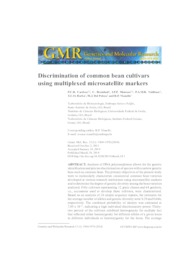Discrimination of common bean cultivars using multiplexed microsatellite markers.
Discrimination of common bean cultivars using multiplexed microsatellite markers.
Author(s): CARDOSO, P. C. B.; BRONDANI, C.; MENEZES, I. P. P.; VALDISSER, P. A. M. R.; BORBA, T. C. O.; DEL PELOSO, M. J.; VIANELLO, R. P.
Summary: Analysis of DNA polymorphisms allows for the genetic identification and precise discrimination of species with a narrow genetic base such as common bean. The primary objectives of the present study were to molecularly characterize commercial common bean varieties developed at various research institutions using microsatellite markers and to determine the degree of genetic diversity among the bean varieties analyzed. Fifty cultivars representing 12 grain classes and 64 genitors, i.e., accessions used to develop these cultivars, were characterized. Based on an analysis of 24 simple sequence repeats, the estimates for the average number of alleles and genetic diversity were 8.29 and 0.646, respectively. The combined probability of identity was estimated at 7.05 x 10(-17), indicating a high individual discriminatory power. Thirty-two percent of the cultivars exhibited heterogeneity for multiple loci that reflected either homozygosity for different alleles of a given locus in different individuals or heterozygosity for the locus. The average genetic diversity for the groups of cultivars and genitors was 0.605 and 0.660, respectively, with no genetic differentiation (F-ST) between these groups. Although similar estimates of expected heterozygosity were observed when the cultivars were grouped by release date, a greater number of private alleles was observed in the most recent cultivars. The genetic differentiation among cultivars originating from different institutions was not different from zero (F-ST = 0.01). The molecular profile database derived from these analyses may increase the statistical power of genetic estimates and may be incorporated into breeding programs for common bean. Furthermore, the profiles obtained for the different cultivars may be used as molecular descriptors to complement traditional descriptors used in distinctiveness, uniformity and stability tests, thereby improving the traceability of samples and their derivatives and helping to protect the intellectual property rights of breeders.
Publication year: 2014
Types of publication: Journal article
Unit: Embrapa Rice & Beans
Keywords: DNA, Diversidade genética, Feijão, Marcador molecular, Phaseolus vulgaris
Observation
Some of Embrapa's publications are published as ePub files. To read them, use or download one of the following free software options to your computer or mobile device. Android: Google Play Books; IOS: iBooks; Windows and Linux: Calibre.
Access other publications
Access the Agricultural Research Database (BDPA) to consult Embrapa's full library collection and records.
Visit Embrapa Bookstore to purchase books and other publications sold by Embrapa.

